On the Slow Train (27 page)
Authors: Michael Williams

More detailed literature will be found in the lists and back catalogues of the following publishers: Ian Allan, David and Charles, the Oakwood Press, the Oxford Publishing Company and the Middleton Press. One of the best selections of out-of-print books on railways can be found appropriately at the unspoilt railway station at Stamford in Lincolnshire, where the slow trains continue to stop and the booksellers, Robert Humm and Co. occupy the former booking office.
ACKNOWLEDGEMENTS
Special thanks to Paul Bigland, Rupert Brennan-Brown, Patrick Janson-Smith, Brian MacArthur, Chris Milner, Melanie Powell, Marcus Robertson and Hassard Stacpoole for their inspiration and encouragement in writing this book; to my publisher Trevor Dolby for suggesting the idea and my agent Sheila Ableman for keeping me on the right track. I'm very grateful also to Paul Bigland, Chris Milner and Anthony Lambert for reading the manuscript and for their expert suggestions and additions, and to Michael Ward of the University of Central Lancashire for providing study leave to ensure the project was finished speedily and is thus as up-to-date as possible. All errors are obviously mine.
Writing about railways is necessarily a minefield, since so intense is the British national passion for trains, there will always (rightly) be someone, somewhere who knows better than me. I'd be delighted to receive comments and corrections, which may be sent to
[email protected]
, bearing in mind that I have tried to convey a reporter's view of travelling on Britain's rail network in 2009 rather than to produce a detailed historical or technical account. There are many of these in existence already, which are infinitely more detailed than anything achievable within the scope of this book â although often somewhat drier in tone.
Thanks too to Steven Knight of Virgin Trains for his generous support and faith in the book, as well as Sue Evans of First Great Western, John Gelson and Peter Meades of National Express, Emma Knight of South West Trains and Iain Wilson of First ScotRail. I have had invaluable help from Neil Buxton and his enthusiastic staff and volunteers at the Association of Community Rail Partnerships. There are others too numerous to mention, but I owe the biggest debt to the hundreds of ordinary passengers and railway staff I met on trains and railway stations during thousands of miles of travel between the early spring and late autumn of 2009, who took the time to chat and share a little bit of their lives with me. Without the âkindness of strangers' this book could never have been written.
LIST OF ILLUSTRATIONS
1
. End of an era © Railway Magazine Archive
2
. We do like to be beside the seaside © St Ives Trust Archive Study Centre
3
. High drama © National Railway Museum/SSPL
4
. Watching the trains go by © National Railway Museum/SSPL
5
. London's last terminus © National Railway Museum/SSPL
6
. Steely heritage © Railway Magazine Archive
7
. Age of elegance © Getty Images/Popperfoto
8
. A breath of fresh air © National Railway Museum/SSPL
9
. My heart's in the Highlands © Railway Magazine Archive
10
. Little train, big journey © Michael Williams
11
. The train that ran on the road © Railway Magazine Archive
12
. Where time stands still © Sheila Hutchinson Collection
13
. Journey's end © Railway Magazine Archive

End of an era: Former Great Western Railway âCastle' No. 5001 gets the âright away' from Banbury on the 1.10 p.m. Paddington to Wolverhampton on the final day of regular steam working on the Birmingham line, 9 September 1962.
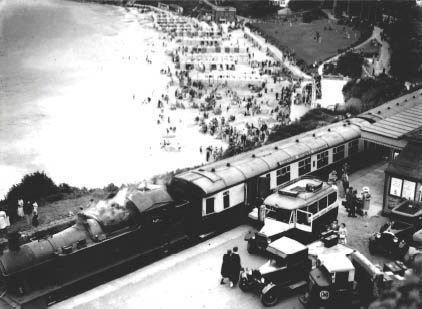
We do like to be beside the seaside: The Cornish Riviera Express arrives at St Ives station on a summer's day in the 1930s. Although Beeching wanted to close it, the line was reprieved and is flourishing again today.
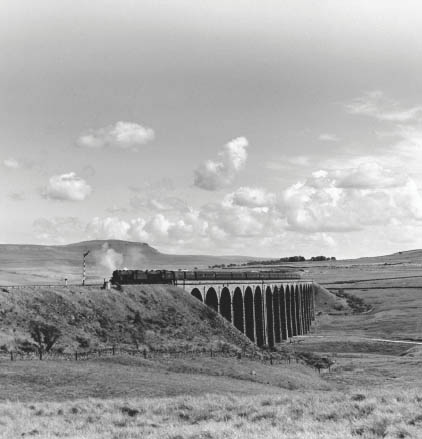
High drama: A âBlack Five' and a âJubilee' double-head the Waverley Express over the Ribblehead viaduct,
c
. 1958. The picture is by Eric Treacy, Bishop of Wakefield, one of the line's most devoted enthusiasts.
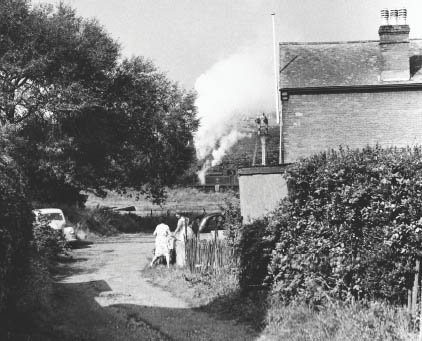
Watching the trains go by: Elderly âClass 02' tank engine No. 31 Chale moves an empty stock train out of Ryde St John's Road as the end of steam on the Isle of Wight draws near in 1963.
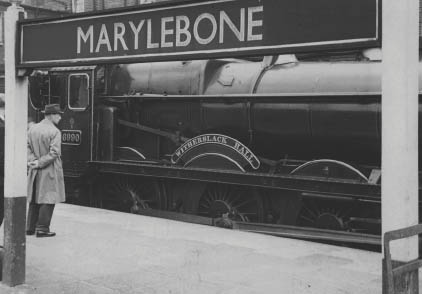
London's last terminus: Great Western Railway âHall Class' No. 6990 Witherslack Hall at Marylebone in June 1948. This was once the sleepiest of stations where the atmosphere was described as one of âcloistered calm'.
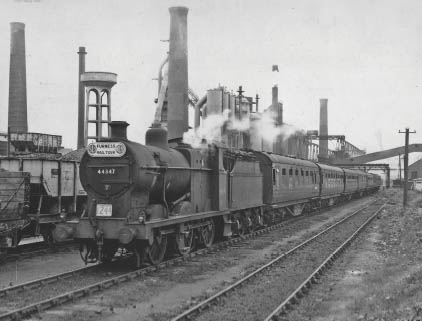
Steely heritage: Ex-LMS âClass 4F' No. 44347 heads a special train past Millom Ironworks on the Cumbrian Coast line in August 1961. The industry has vanished and the site where the furnaces stood is now a bird sanctuary.

Age of elegance: The Golden Arrow at London's Victoria station in 1957. With its luxurious Pullman cars and fine dining, the LondonâParis service was always among the most glamorous of trains.

A breath of fresh air: Now rebranded the âLondon Overground', the route of the old North London Railway still links the capital's green oases of Hampstead Heath, Kew Gardens and Richmond. Poster, 1870â1913.
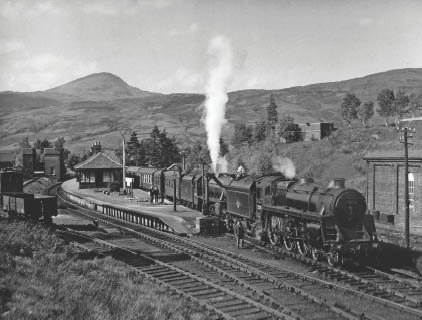
My heart's in the Highlands: âStandard Class 5' No. 73078 and ex-LMS âBlack Five' No. 44976 take water at Crianlarich with the 2.56 p.m. restaurant car train from Fort William to Glasgow in May 1959.
